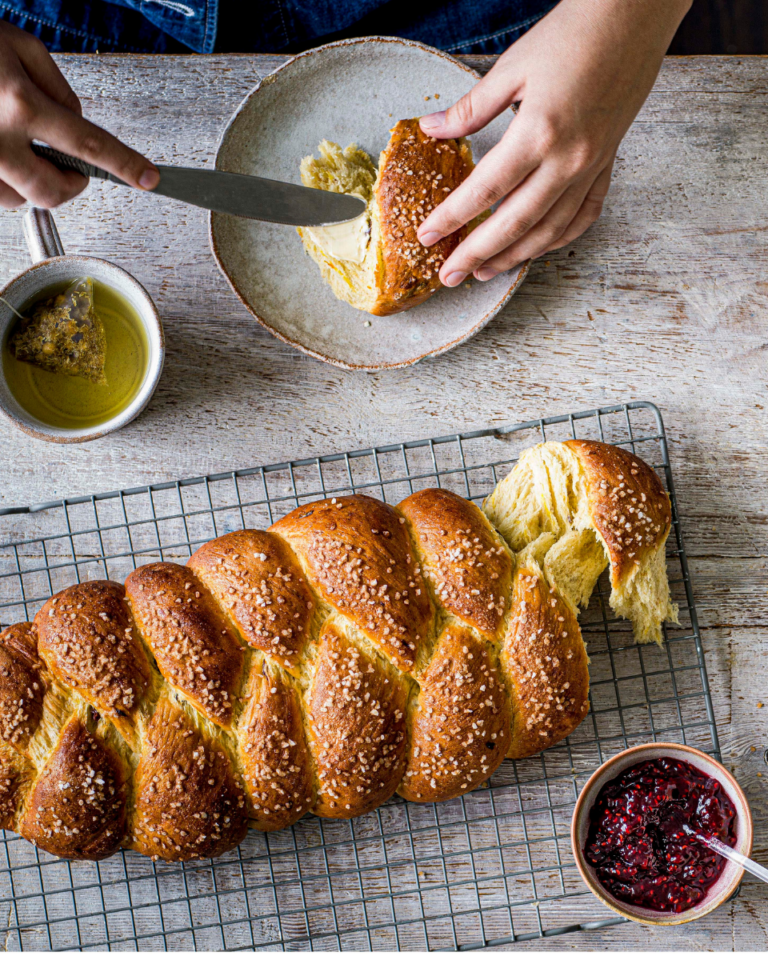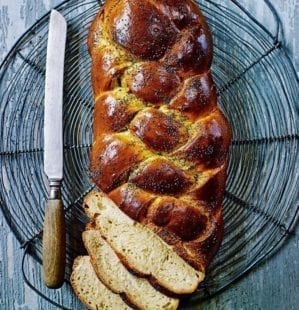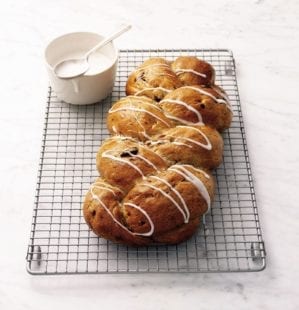
David Atherton’s plaited loaf (Kozunak plait)
- Published: 23 Dec 21
- Updated: 18 Mar 24
This is a Kozunak plait – a celebratory bread that hails from Bulgaria. It’s essentially a plaited enriched loaf – similar to the Jewish challah. Adding honey to the recipe and brushing with egg wash ensures you get a lacquered golden brown finish. In Bulgaria the flavourings in this loaf vary, but plump raisins and the plaited shape are a must.

Recipe taken from Good to Eat by David Atherton (Hodder & Stoughton £25)
-
Makes 1 loaf (10 slices)
-
Hands-on time 25 min, plus soaking, resting and proving. Oven time, 30 min.
Ingredients
- Fat-fingered pinch saffron threads (or less if you prefer)
- 200ml warm water
- 50g raisins
- 220g caster sugar
- 450g strong white bread flour
- 50g strong wholemeal bread flour
- 10g instant (fast action) yeast
- Heaped 1/2 tsp salt
- 100ml semi-skimmed milk
- 40g softened unsalted butter
- 30g runny honey
- 1 tsp vanilla paste
- Finely grated zest 1 lemon, or 10 drops lemon oil
- 25g grated butternut squash or carrot
- 1 medium free-range egg
- 10g pearl sugar nibs (from the baking aisle of supermarkets)
- 10g caster sugar
Method
- Soak the saffron in a bowl with the warm water for 10 minutes. Add the raisins to a heatproof bowl, just cover with boiling water and leave these to soak for 10 minutes too.
- Toss the flours, yeast and salt together, then add the milk and saffron water and mix to form a shaggy dough. (Combine until the dough just comes together.) Cover with a beeswax wrap or cling film and rest for 15 minutes.
- Knead for 1 minute in the bowl. Add the butter, honey, vanilla, zest/lemon oil and squash/carrot. Knead until incorporated and smooth (about 15 minutes). It will be sticky at first – it’s easiest to use a dough hook in a stand mixer (see Know-how). Drain the raisins, then knead into the dough. Cover and leave in a warm place until doubled in size (about 1 hour).
- Knock back the dough (push it down to remove any large air bubbles), then decide how you want to plait the bread – I like a three-strand plait. (To see a video showing how to plait the loaf, scroll down to Tips)
- Put the loaf on a lined baking tray, cover with an oiled piece of cling film and leave until doubled in size (about 30 minutes, but don’t worry if it takes longer). Heat the oven to 200°C fan/gas 7.
- Beat the egg, then use a soft brush to egg wash the plait. Sprinkle with the sugar nibs, then the sugar. Bake for 5 minutes, then reduce the temperature of the oven to 180°C fan/gas 6. Bake for a further 25 minutes. Cool slightly before eating.
- Recipe from January 2022 Issue
Nutrition
- Calories
- 261kcals
- Fat
- 4.8g (2.6g saturated)
- Protein
- 6.8g
- Carbohydrates
- 46.5g (8.7g sugars)
- Fibre
- 2.5g
- Salt
- 0.3g
delicious. tips
Don’t waste it: The bread is best eaten on the day it’s made, but will keep in an airtight container for several days. Toast leftovers and spread with butter and jam, or thickly slice and use to make French toast or bread and butter pudding.
Watch three ways to plait the loaf here:
Soaking dried fruit, nuts or seeds in water before you add them to the dough will prevent them from drying out the bread and keep them soft when baked. If using a stand mixer, mix the ingredients on a low speed until fully incorporated, then increase the speed to medium and knead until the dough is smooth, shiny and comes away from the sides of the bowl (about 10 minutes). Enriched bread doughs often take a little longer to rise as the addition of fat inhibits the yeast.
To check if the dough is ready, gently press it with a finger. If it springs back immediately, it needs more proving. If it holds for a moment, then slowly returns to its original position, the dough is ready to bake.
Don’t plait the loaf too tightly – it needs room to expand during proving and baking.
Buy ingredients online
Rate & review
Rate
Reviews
Subscribe to our magazine
Food stories, skills and tested recipes, straight to your door... Enjoy 5 issues for just £5 with our special introductory offer.
Subscribe
Unleash your inner chef
Looking for inspiration? Receive the latest recipes with our newsletter


